London College Of Business Studies
VerifiedAdded on 2022/08/13
|15
|4924
|18
AI Summary
Hi! Here are 2 reports for this assignment. the first one is for 2000 words and must include LO1 and LO2. THE second one has the same 2000 words and must include LO3 and LO4. all the details you have attached.
Contribute Materials
Your contribution can guide someone’s learning journey. Share your
documents today.
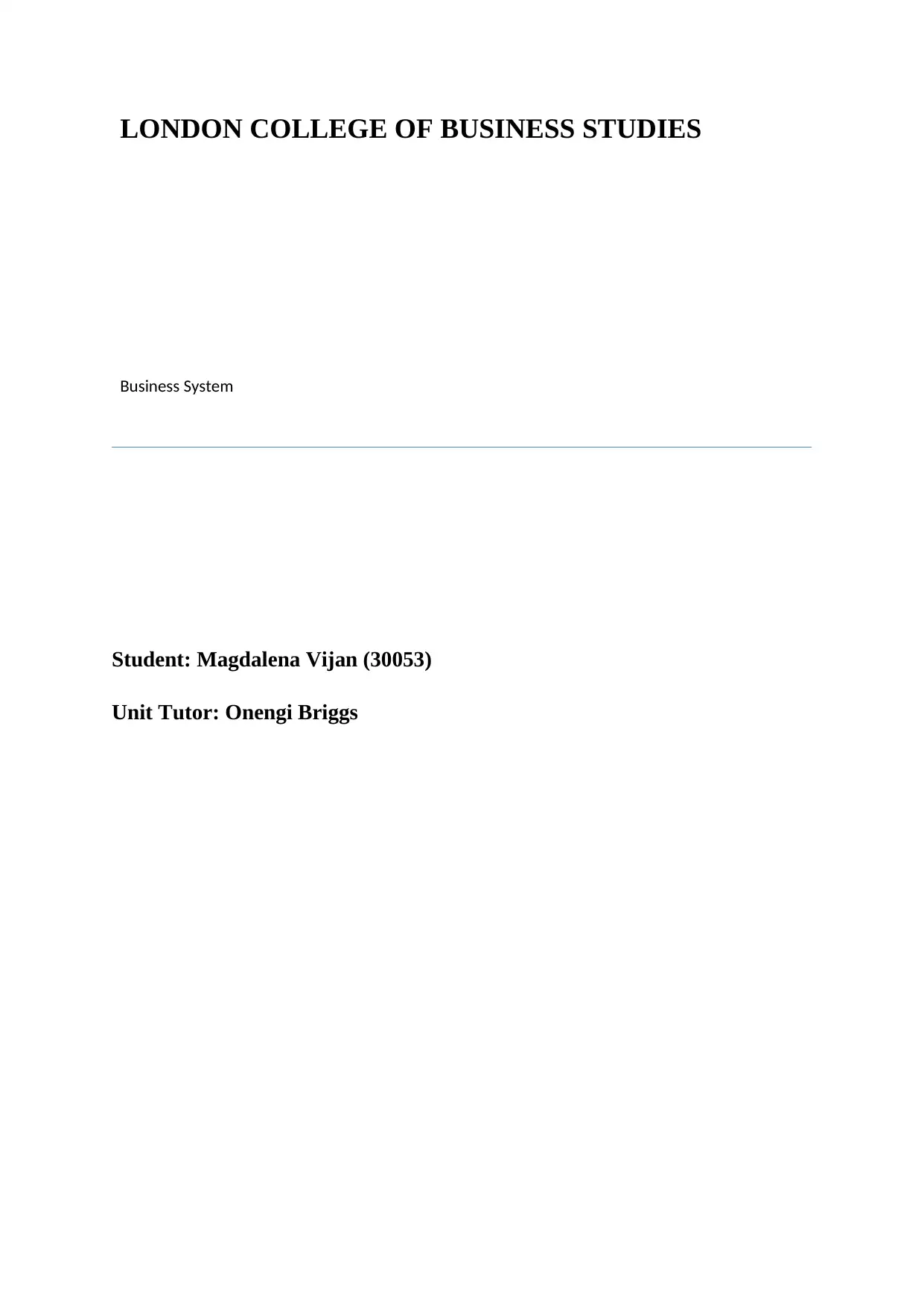
LONDON COLLEGE OF BUSINESS STUDIES
Business System
Student: Magdalena Vijan (30053)
Unit Tutor: Onengi Briggs
Business System
Student: Magdalena Vijan (30053)
Unit Tutor: Onengi Briggs
Secure Best Marks with AI Grader
Need help grading? Try our AI Grader for instant feedback on your assignments.
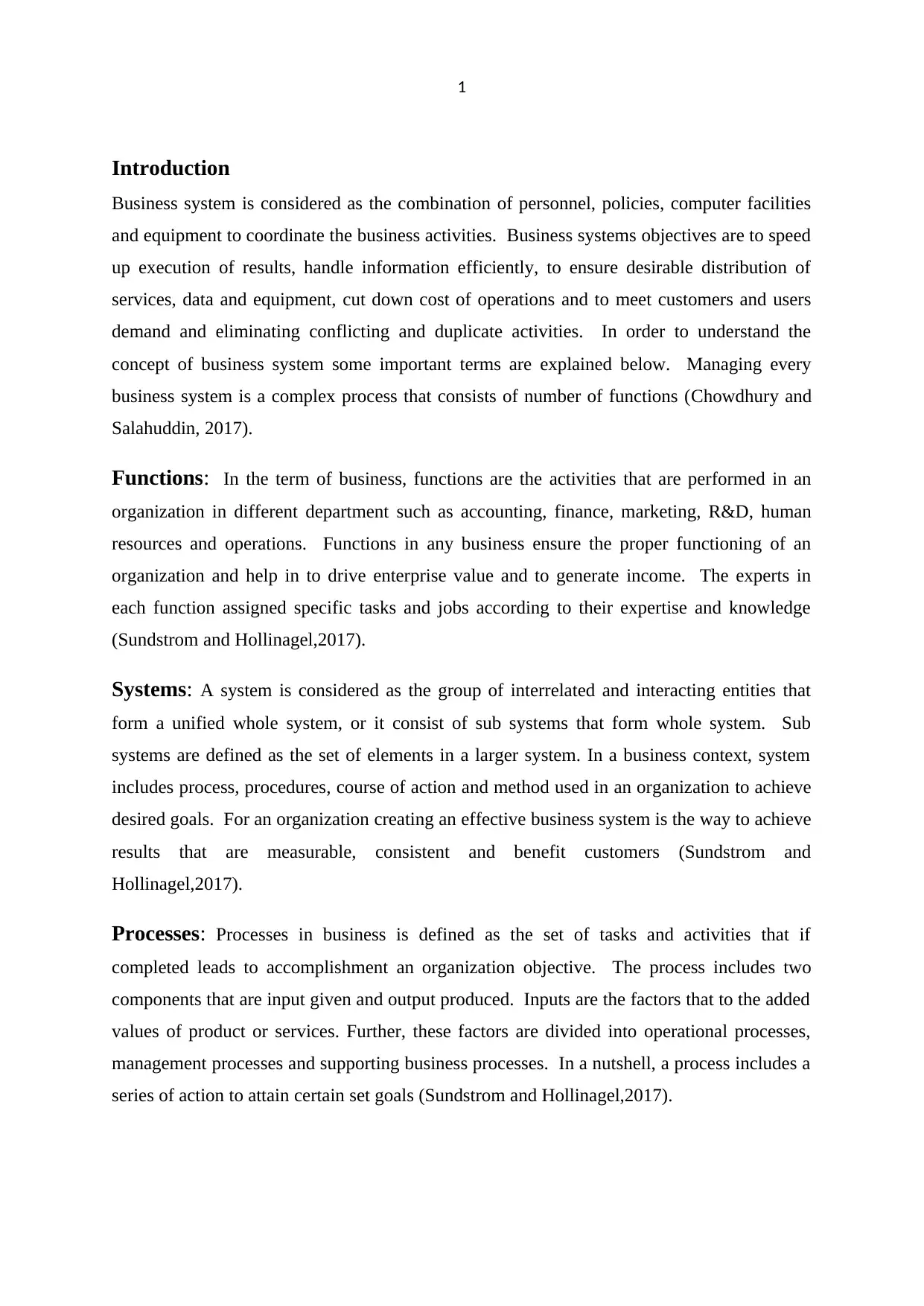
1
Introduction
Business system is considered as the combination of personnel, policies, computer facilities
and equipment to coordinate the business activities. Business systems objectives are to speed
up execution of results, handle information efficiently, to ensure desirable distribution of
services, data and equipment, cut down cost of operations and to meet customers and users
demand and eliminating conflicting and duplicate activities. In order to understand the
concept of business system some important terms are explained below. Managing every
business system is a complex process that consists of number of functions (Chowdhury and
Salahuddin, 2017).
Functions: In the term of business, functions are the activities that are performed in an
organization in different department such as accounting, finance, marketing, R&D, human
resources and operations. Functions in any business ensure the proper functioning of an
organization and help in to drive enterprise value and to generate income. The experts in
each function assigned specific tasks and jobs according to their expertise and knowledge
(Sundstrom and Hollinagel,2017).
Systems: A system is considered as the group of interrelated and interacting entities that
form a unified whole system, or it consist of sub systems that form whole system. Sub
systems are defined as the set of elements in a larger system. In a business context, system
includes process, procedures, course of action and method used in an organization to achieve
desired goals. For an organization creating an effective business system is the way to achieve
results that are measurable, consistent and benefit customers (Sundstrom and
Hollinagel,2017).
Processes: Processes in business is defined as the set of tasks and activities that if
completed leads to accomplishment an organization objective. The process includes two
components that are input given and output produced. Inputs are the factors that to the added
values of product or services. Further, these factors are divided into operational processes,
management processes and supporting business processes. In a nutshell, a process includes a
series of action to attain certain set goals (Sundstrom and Hollinagel,2017).
Introduction
Business system is considered as the combination of personnel, policies, computer facilities
and equipment to coordinate the business activities. Business systems objectives are to speed
up execution of results, handle information efficiently, to ensure desirable distribution of
services, data and equipment, cut down cost of operations and to meet customers and users
demand and eliminating conflicting and duplicate activities. In order to understand the
concept of business system some important terms are explained below. Managing every
business system is a complex process that consists of number of functions (Chowdhury and
Salahuddin, 2017).
Functions: In the term of business, functions are the activities that are performed in an
organization in different department such as accounting, finance, marketing, R&D, human
resources and operations. Functions in any business ensure the proper functioning of an
organization and help in to drive enterprise value and to generate income. The experts in
each function assigned specific tasks and jobs according to their expertise and knowledge
(Sundstrom and Hollinagel,2017).
Systems: A system is considered as the group of interrelated and interacting entities that
form a unified whole system, or it consist of sub systems that form whole system. Sub
systems are defined as the set of elements in a larger system. In a business context, system
includes process, procedures, course of action and method used in an organization to achieve
desired goals. For an organization creating an effective business system is the way to achieve
results that are measurable, consistent and benefit customers (Sundstrom and
Hollinagel,2017).
Processes: Processes in business is defined as the set of tasks and activities that if
completed leads to accomplishment an organization objective. The process includes two
components that are input given and output produced. Inputs are the factors that to the added
values of product or services. Further, these factors are divided into operational processes,
management processes and supporting business processes. In a nutshell, a process includes a
series of action to attain certain set goals (Sundstrom and Hollinagel,2017).
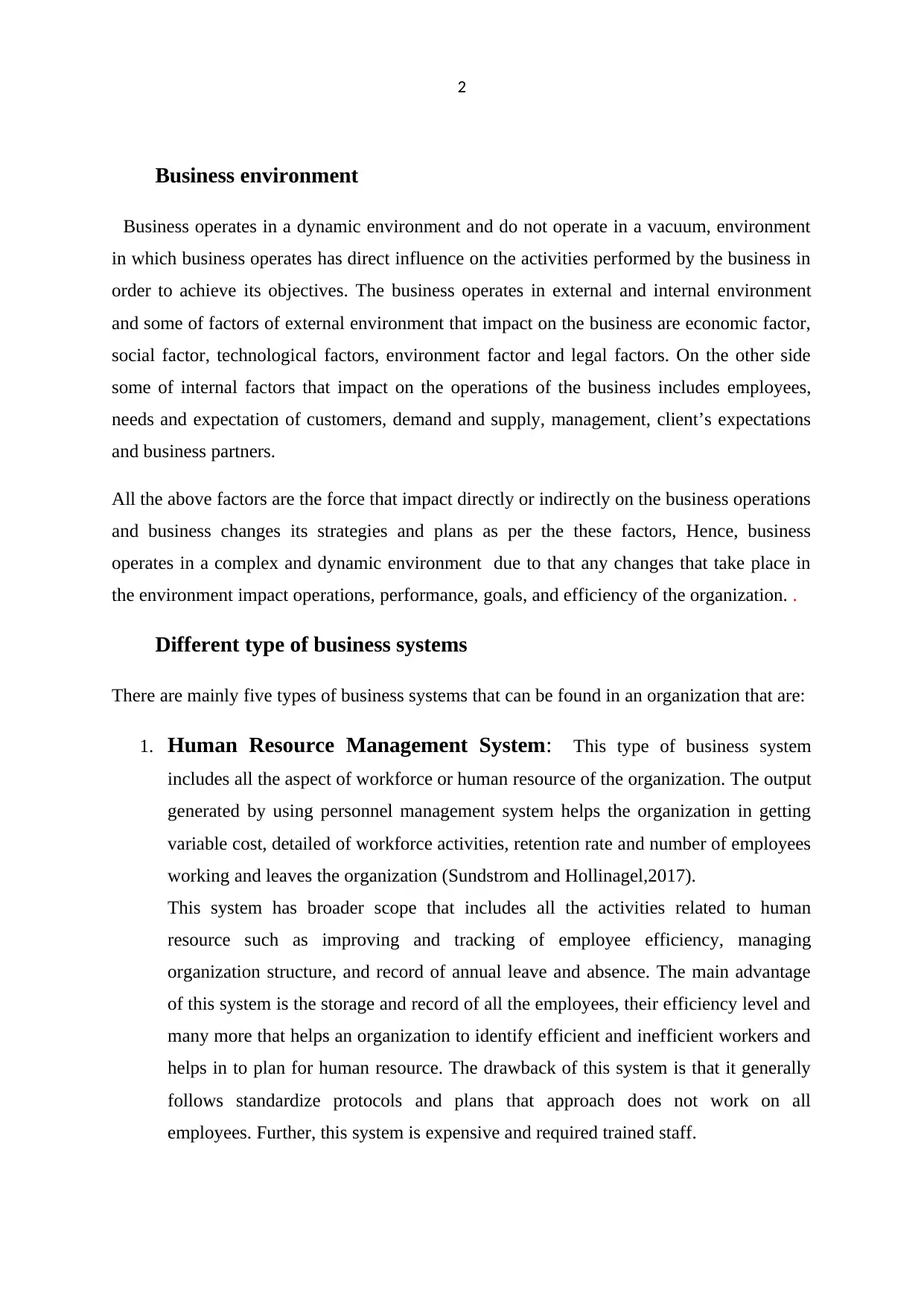
2
Business environment
Business operates in a dynamic environment and do not operate in a vacuum, environment
in which business operates has direct influence on the activities performed by the business in
order to achieve its objectives. The business operates in external and internal environment
and some of factors of external environment that impact on the business are economic factor,
social factor, technological factors, environment factor and legal factors. On the other side
some of internal factors that impact on the operations of the business includes employees,
needs and expectation of customers, demand and supply, management, client’s expectations
and business partners.
All the above factors are the force that impact directly or indirectly on the business operations
and business changes its strategies and plans as per the these factors, Hence, business
operates in a complex and dynamic environment due to that any changes that take place in
the environment impact operations, performance, goals, and efficiency of the organization. .
Different type of business systems
There are mainly five types of business systems that can be found in an organization that are:
1. Human Resource Management System: This type of business system
includes all the aspect of workforce or human resource of the organization. The output
generated by using personnel management system helps the organization in getting
variable cost, detailed of workforce activities, retention rate and number of employees
working and leaves the organization (Sundstrom and Hollinagel,2017).
This system has broader scope that includes all the activities related to human
resource such as improving and tracking of employee efficiency, managing
organization structure, and record of annual leave and absence. The main advantage
of this system is the storage and record of all the employees, their efficiency level and
many more that helps an organization to identify efficient and inefficient workers and
helps in to plan for human resource. The drawback of this system is that it generally
follows standardize protocols and plans that approach does not work on all
employees. Further, this system is expensive and required trained staff.
Business environment
Business operates in a dynamic environment and do not operate in a vacuum, environment
in which business operates has direct influence on the activities performed by the business in
order to achieve its objectives. The business operates in external and internal environment
and some of factors of external environment that impact on the business are economic factor,
social factor, technological factors, environment factor and legal factors. On the other side
some of internal factors that impact on the operations of the business includes employees,
needs and expectation of customers, demand and supply, management, client’s expectations
and business partners.
All the above factors are the force that impact directly or indirectly on the business operations
and business changes its strategies and plans as per the these factors, Hence, business
operates in a complex and dynamic environment due to that any changes that take place in
the environment impact operations, performance, goals, and efficiency of the organization. .
Different type of business systems
There are mainly five types of business systems that can be found in an organization that are:
1. Human Resource Management System: This type of business system
includes all the aspect of workforce or human resource of the organization. The output
generated by using personnel management system helps the organization in getting
variable cost, detailed of workforce activities, retention rate and number of employees
working and leaves the organization (Sundstrom and Hollinagel,2017).
This system has broader scope that includes all the activities related to human
resource such as improving and tracking of employee efficiency, managing
organization structure, and record of annual leave and absence. The main advantage
of this system is the storage and record of all the employees, their efficiency level and
many more that helps an organization to identify efficient and inefficient workers and
helps in to plan for human resource. The drawback of this system is that it generally
follows standardize protocols and plans that approach does not work on all
employees. Further, this system is expensive and required trained staff.
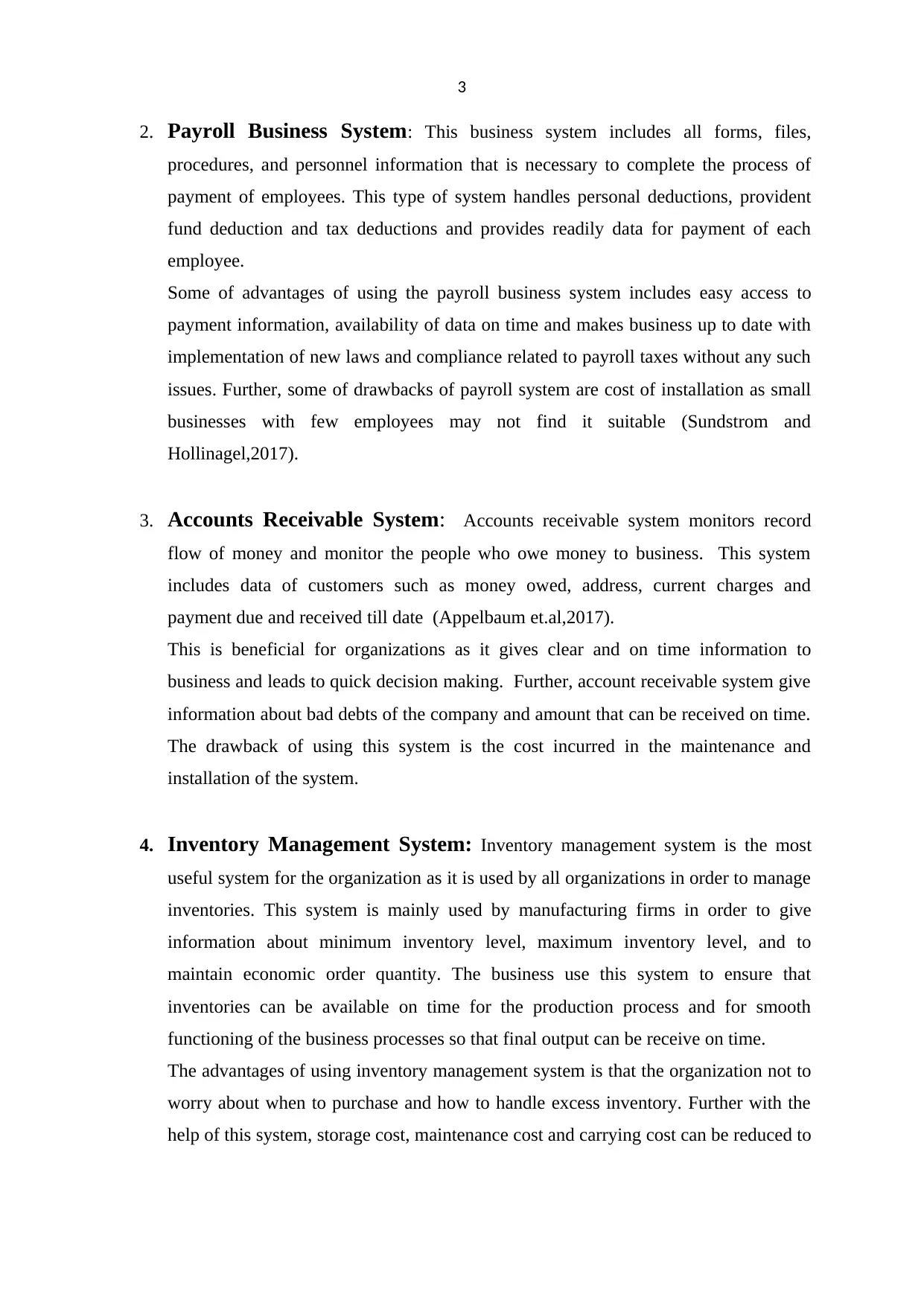
3
2. Payroll Business System: This business system includes all forms, files,
procedures, and personnel information that is necessary to complete the process of
payment of employees. This type of system handles personal deductions, provident
fund deduction and tax deductions and provides readily data for payment of each
employee.
Some of advantages of using the payroll business system includes easy access to
payment information, availability of data on time and makes business up to date with
implementation of new laws and compliance related to payroll taxes without any such
issues. Further, some of drawbacks of payroll system are cost of installation as small
businesses with few employees may not find it suitable (Sundstrom and
Hollinagel,2017).
3. Accounts Receivable System: Accounts receivable system monitors record
flow of money and monitor the people who owe money to business. This system
includes data of customers such as money owed, address, current charges and
payment due and received till date (Appelbaum et.al,2017).
This is beneficial for organizations as it gives clear and on time information to
business and leads to quick decision making. Further, account receivable system give
information about bad debts of the company and amount that can be received on time.
The drawback of using this system is the cost incurred in the maintenance and
installation of the system.
4. Inventory Management System: Inventory management system is the most
useful system for the organization as it is used by all organizations in order to manage
inventories. This system is mainly used by manufacturing firms in order to give
information about minimum inventory level, maximum inventory level, and to
maintain economic order quantity. The business use this system to ensure that
inventories can be available on time for the production process and for smooth
functioning of the business processes so that final output can be receive on time.
The advantages of using inventory management system is that the organization not to
worry about when to purchase and how to handle excess inventory. Further with the
help of this system, storage cost, maintenance cost and carrying cost can be reduced to
2. Payroll Business System: This business system includes all forms, files,
procedures, and personnel information that is necessary to complete the process of
payment of employees. This type of system handles personal deductions, provident
fund deduction and tax deductions and provides readily data for payment of each
employee.
Some of advantages of using the payroll business system includes easy access to
payment information, availability of data on time and makes business up to date with
implementation of new laws and compliance related to payroll taxes without any such
issues. Further, some of drawbacks of payroll system are cost of installation as small
businesses with few employees may not find it suitable (Sundstrom and
Hollinagel,2017).
3. Accounts Receivable System: Accounts receivable system monitors record
flow of money and monitor the people who owe money to business. This system
includes data of customers such as money owed, address, current charges and
payment due and received till date (Appelbaum et.al,2017).
This is beneficial for organizations as it gives clear and on time information to
business and leads to quick decision making. Further, account receivable system give
information about bad debts of the company and amount that can be received on time.
The drawback of using this system is the cost incurred in the maintenance and
installation of the system.
4. Inventory Management System: Inventory management system is the most
useful system for the organization as it is used by all organizations in order to manage
inventories. This system is mainly used by manufacturing firms in order to give
information about minimum inventory level, maximum inventory level, and to
maintain economic order quantity. The business use this system to ensure that
inventories can be available on time for the production process and for smooth
functioning of the business processes so that final output can be receive on time.
The advantages of using inventory management system is that the organization not to
worry about when to purchase and how to handle excess inventory. Further with the
help of this system, storage cost, maintenance cost and carrying cost can be reduced to
Secure Best Marks with AI Grader
Need help grading? Try our AI Grader for instant feedback on your assignments.
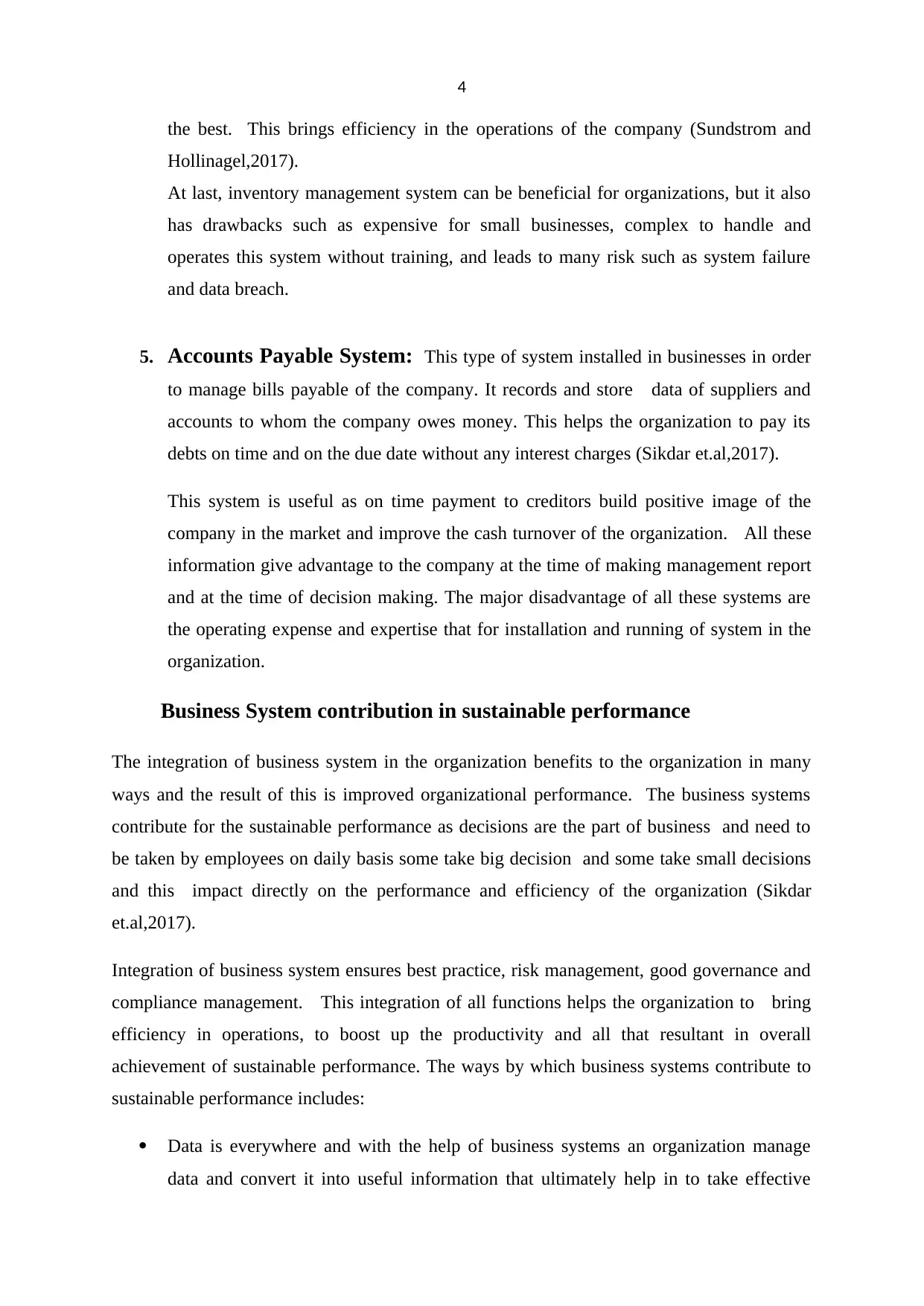
4
the best. This brings efficiency in the operations of the company (Sundstrom and
Hollinagel,2017).
At last, inventory management system can be beneficial for organizations, but it also
has drawbacks such as expensive for small businesses, complex to handle and
operates this system without training, and leads to many risk such as system failure
and data breach.
5. Accounts Payable System: This type of system installed in businesses in order
to manage bills payable of the company. It records and store data of suppliers and
accounts to whom the company owes money. This helps the organization to pay its
debts on time and on the due date without any interest charges (Sikdar et.al,2017).
This system is useful as on time payment to creditors build positive image of the
company in the market and improve the cash turnover of the organization. All these
information give advantage to the company at the time of making management report
and at the time of decision making. The major disadvantage of all these systems are
the operating expense and expertise that for installation and running of system in the
organization.
Business System contribution in sustainable performance
The integration of business system in the organization benefits to the organization in many
ways and the result of this is improved organizational performance. The business systems
contribute for the sustainable performance as decisions are the part of business and need to
be taken by employees on daily basis some take big decision and some take small decisions
and this impact directly on the performance and efficiency of the organization (Sikdar
et.al,2017).
Integration of business system ensures best practice, risk management, good governance and
compliance management. This integration of all functions helps the organization to bring
efficiency in operations, to boost up the productivity and all that resultant in overall
achievement of sustainable performance. The ways by which business systems contribute to
sustainable performance includes:
Data is everywhere and with the help of business systems an organization manage
data and convert it into useful information that ultimately help in to take effective
the best. This brings efficiency in the operations of the company (Sundstrom and
Hollinagel,2017).
At last, inventory management system can be beneficial for organizations, but it also
has drawbacks such as expensive for small businesses, complex to handle and
operates this system without training, and leads to many risk such as system failure
and data breach.
5. Accounts Payable System: This type of system installed in businesses in order
to manage bills payable of the company. It records and store data of suppliers and
accounts to whom the company owes money. This helps the organization to pay its
debts on time and on the due date without any interest charges (Sikdar et.al,2017).
This system is useful as on time payment to creditors build positive image of the
company in the market and improve the cash turnover of the organization. All these
information give advantage to the company at the time of making management report
and at the time of decision making. The major disadvantage of all these systems are
the operating expense and expertise that for installation and running of system in the
organization.
Business System contribution in sustainable performance
The integration of business system in the organization benefits to the organization in many
ways and the result of this is improved organizational performance. The business systems
contribute for the sustainable performance as decisions are the part of business and need to
be taken by employees on daily basis some take big decision and some take small decisions
and this impact directly on the performance and efficiency of the organization (Sikdar
et.al,2017).
Integration of business system ensures best practice, risk management, good governance and
compliance management. This integration of all functions helps the organization to bring
efficiency in operations, to boost up the productivity and all that resultant in overall
achievement of sustainable performance. The ways by which business systems contribute to
sustainable performance includes:
Data is everywhere and with the help of business systems an organization manage
data and convert it into useful information that ultimately help in to take effective
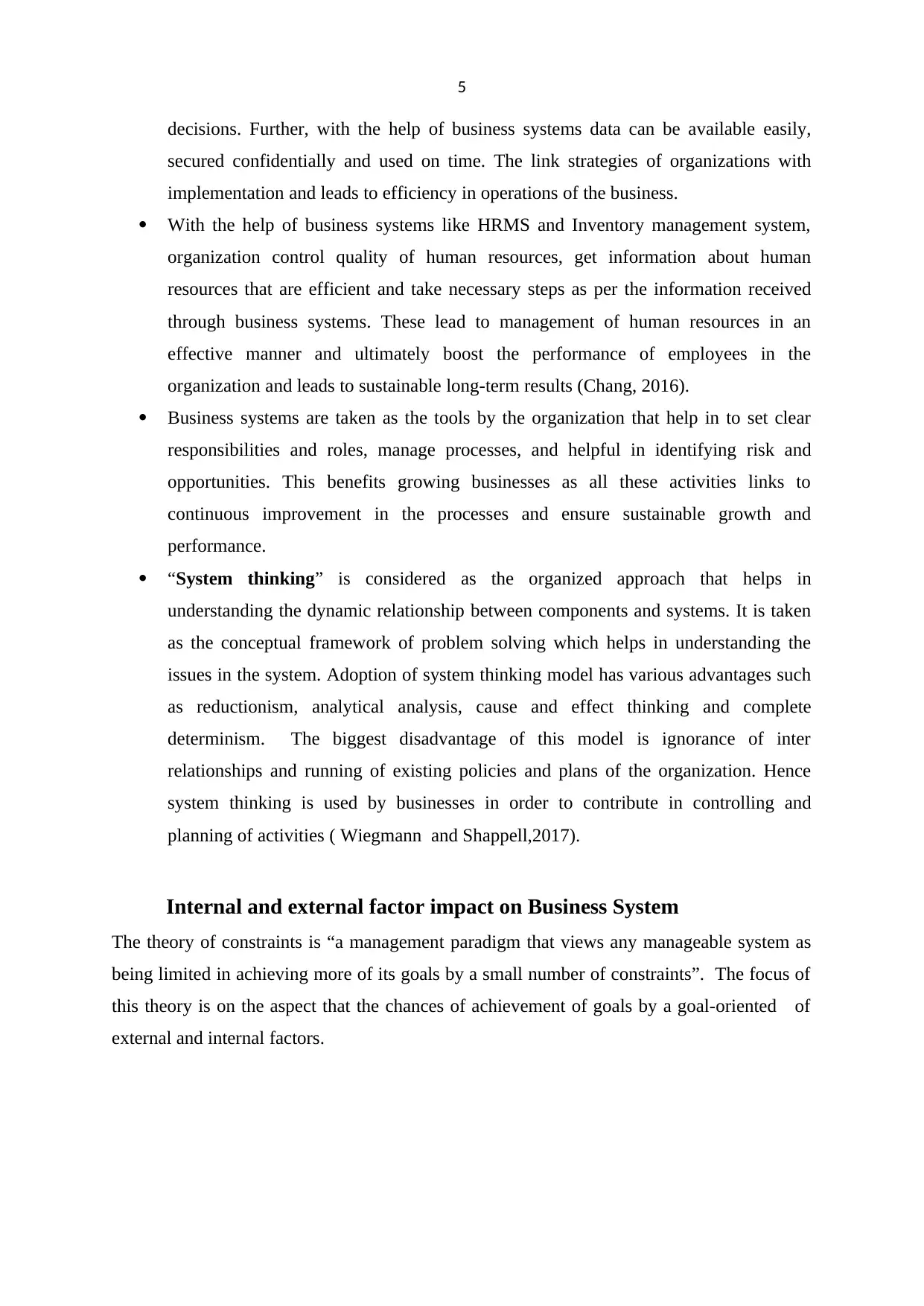
5
decisions. Further, with the help of business systems data can be available easily,
secured confidentially and used on time. The link strategies of organizations with
implementation and leads to efficiency in operations of the business.
With the help of business systems like HRMS and Inventory management system,
organization control quality of human resources, get information about human
resources that are efficient and take necessary steps as per the information received
through business systems. These lead to management of human resources in an
effective manner and ultimately boost the performance of employees in the
organization and leads to sustainable long-term results (Chang, 2016).
Business systems are taken as the tools by the organization that help in to set clear
responsibilities and roles, manage processes, and helpful in identifying risk and
opportunities. This benefits growing businesses as all these activities links to
continuous improvement in the processes and ensure sustainable growth and
performance.
“System thinking” is considered as the organized approach that helps in
understanding the dynamic relationship between components and systems. It is taken
as the conceptual framework of problem solving which helps in understanding the
issues in the system. Adoption of system thinking model has various advantages such
as reductionism, analytical analysis, cause and effect thinking and complete
determinism. The biggest disadvantage of this model is ignorance of inter
relationships and running of existing policies and plans of the organization. Hence
system thinking is used by businesses in order to contribute in controlling and
planning of activities ( Wiegmann and Shappell,2017).
Internal and external factor impact on Business System
The theory of constraints is “a management paradigm that views any manageable system as
being limited in achieving more of its goals by a small number of constraints”. The focus of
this theory is on the aspect that the chances of achievement of goals by a goal-oriented of
external and internal factors.
decisions. Further, with the help of business systems data can be available easily,
secured confidentially and used on time. The link strategies of organizations with
implementation and leads to efficiency in operations of the business.
With the help of business systems like HRMS and Inventory management system,
organization control quality of human resources, get information about human
resources that are efficient and take necessary steps as per the information received
through business systems. These lead to management of human resources in an
effective manner and ultimately boost the performance of employees in the
organization and leads to sustainable long-term results (Chang, 2016).
Business systems are taken as the tools by the organization that help in to set clear
responsibilities and roles, manage processes, and helpful in identifying risk and
opportunities. This benefits growing businesses as all these activities links to
continuous improvement in the processes and ensure sustainable growth and
performance.
“System thinking” is considered as the organized approach that helps in
understanding the dynamic relationship between components and systems. It is taken
as the conceptual framework of problem solving which helps in understanding the
issues in the system. Adoption of system thinking model has various advantages such
as reductionism, analytical analysis, cause and effect thinking and complete
determinism. The biggest disadvantage of this model is ignorance of inter
relationships and running of existing policies and plans of the organization. Hence
system thinking is used by businesses in order to contribute in controlling and
planning of activities ( Wiegmann and Shappell,2017).
Internal and external factor impact on Business System
The theory of constraints is “a management paradigm that views any manageable system as
being limited in achieving more of its goals by a small number of constraints”. The focus of
this theory is on the aspect that the chances of achievement of goals by a goal-oriented of
external and internal factors.
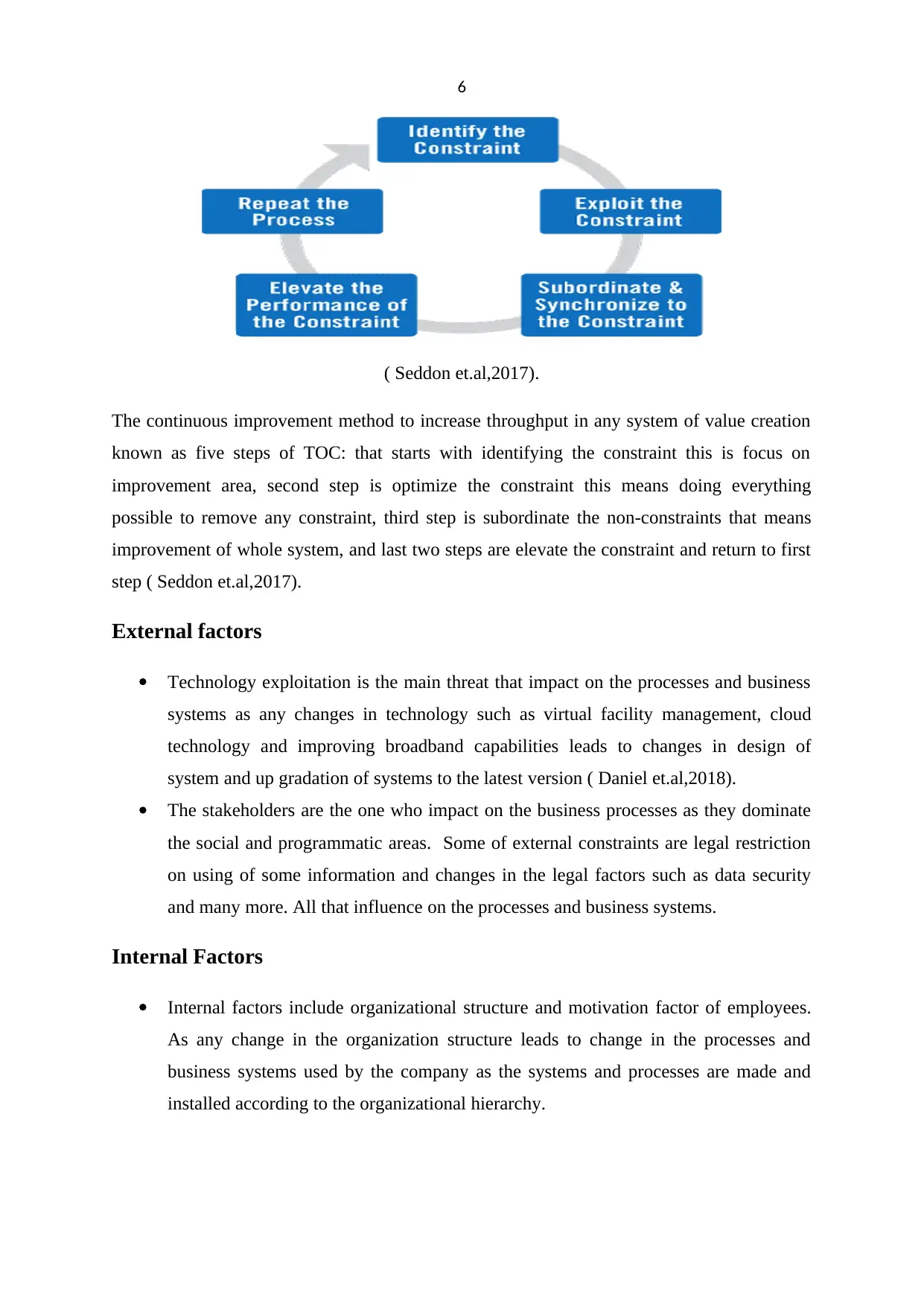
6
( Seddon et.al,2017).
The continuous improvement method to increase throughput in any system of value creation
known as five steps of TOC: that starts with identifying the constraint this is focus on
improvement area, second step is optimize the constraint this means doing everything
possible to remove any constraint, third step is subordinate the non-constraints that means
improvement of whole system, and last two steps are elevate the constraint and return to first
step ( Seddon et.al,2017).
External factors
Technology exploitation is the main threat that impact on the processes and business
systems as any changes in technology such as virtual facility management, cloud
technology and improving broadband capabilities leads to changes in design of
system and up gradation of systems to the latest version ( Daniel et.al,2018).
The stakeholders are the one who impact on the business processes as they dominate
the social and programmatic areas. Some of external constraints are legal restriction
on using of some information and changes in the legal factors such as data security
and many more. All that influence on the processes and business systems.
Internal Factors
Internal factors include organizational structure and motivation factor of employees.
As any change in the organization structure leads to change in the processes and
business systems used by the company as the systems and processes are made and
installed according to the organizational hierarchy.
( Seddon et.al,2017).
The continuous improvement method to increase throughput in any system of value creation
known as five steps of TOC: that starts with identifying the constraint this is focus on
improvement area, second step is optimize the constraint this means doing everything
possible to remove any constraint, third step is subordinate the non-constraints that means
improvement of whole system, and last two steps are elevate the constraint and return to first
step ( Seddon et.al,2017).
External factors
Technology exploitation is the main threat that impact on the processes and business
systems as any changes in technology such as virtual facility management, cloud
technology and improving broadband capabilities leads to changes in design of
system and up gradation of systems to the latest version ( Daniel et.al,2018).
The stakeholders are the one who impact on the business processes as they dominate
the social and programmatic areas. Some of external constraints are legal restriction
on using of some information and changes in the legal factors such as data security
and many more. All that influence on the processes and business systems.
Internal Factors
Internal factors include organizational structure and motivation factor of employees.
As any change in the organization structure leads to change in the processes and
business systems used by the company as the systems and processes are made and
installed according to the organizational hierarchy.
Paraphrase This Document
Need a fresh take? Get an instant paraphrase of this document with our AI Paraphraser
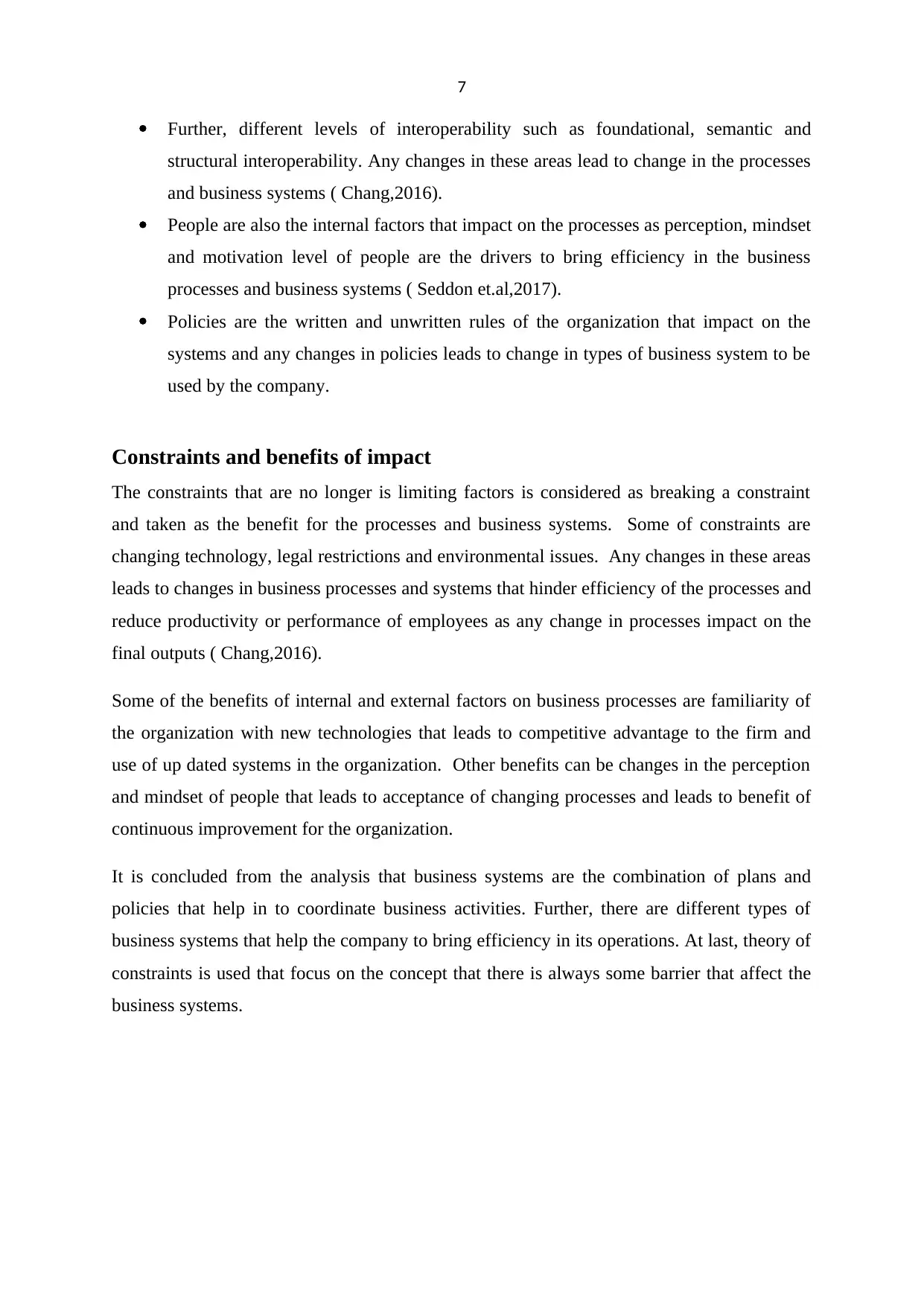
7
Further, different levels of interoperability such as foundational, semantic and
structural interoperability. Any changes in these areas lead to change in the processes
and business systems ( Chang,2016).
People are also the internal factors that impact on the processes as perception, mindset
and motivation level of people are the drivers to bring efficiency in the business
processes and business systems ( Seddon et.al,2017).
Policies are the written and unwritten rules of the organization that impact on the
systems and any changes in policies leads to change in types of business system to be
used by the company.
Constraints and benefits of impact
The constraints that are no longer is limiting factors is considered as breaking a constraint
and taken as the benefit for the processes and business systems. Some of constraints are
changing technology, legal restrictions and environmental issues. Any changes in these areas
leads to changes in business processes and systems that hinder efficiency of the processes and
reduce productivity or performance of employees as any change in processes impact on the
final outputs ( Chang,2016).
Some of the benefits of internal and external factors on business processes are familiarity of
the organization with new technologies that leads to competitive advantage to the firm and
use of up dated systems in the organization. Other benefits can be changes in the perception
and mindset of people that leads to acceptance of changing processes and leads to benefit of
continuous improvement for the organization.
It is concluded from the analysis that business systems are the combination of plans and
policies that help in to coordinate business activities. Further, there are different types of
business systems that help the company to bring efficiency in its operations. At last, theory of
constraints is used that focus on the concept that there is always some barrier that affect the
business systems.
Further, different levels of interoperability such as foundational, semantic and
structural interoperability. Any changes in these areas lead to change in the processes
and business systems ( Chang,2016).
People are also the internal factors that impact on the processes as perception, mindset
and motivation level of people are the drivers to bring efficiency in the business
processes and business systems ( Seddon et.al,2017).
Policies are the written and unwritten rules of the organization that impact on the
systems and any changes in policies leads to change in types of business system to be
used by the company.
Constraints and benefits of impact
The constraints that are no longer is limiting factors is considered as breaking a constraint
and taken as the benefit for the processes and business systems. Some of constraints are
changing technology, legal restrictions and environmental issues. Any changes in these areas
leads to changes in business processes and systems that hinder efficiency of the processes and
reduce productivity or performance of employees as any change in processes impact on the
final outputs ( Chang,2016).
Some of the benefits of internal and external factors on business processes are familiarity of
the organization with new technologies that leads to competitive advantage to the firm and
use of up dated systems in the organization. Other benefits can be changes in the perception
and mindset of people that leads to acceptance of changing processes and leads to benefit of
continuous improvement for the organization.
It is concluded from the analysis that business systems are the combination of plans and
policies that help in to coordinate business activities. Further, there are different types of
business systems that help the company to bring efficiency in its operations. At last, theory of
constraints is used that focus on the concept that there is always some barrier that affect the
business systems.
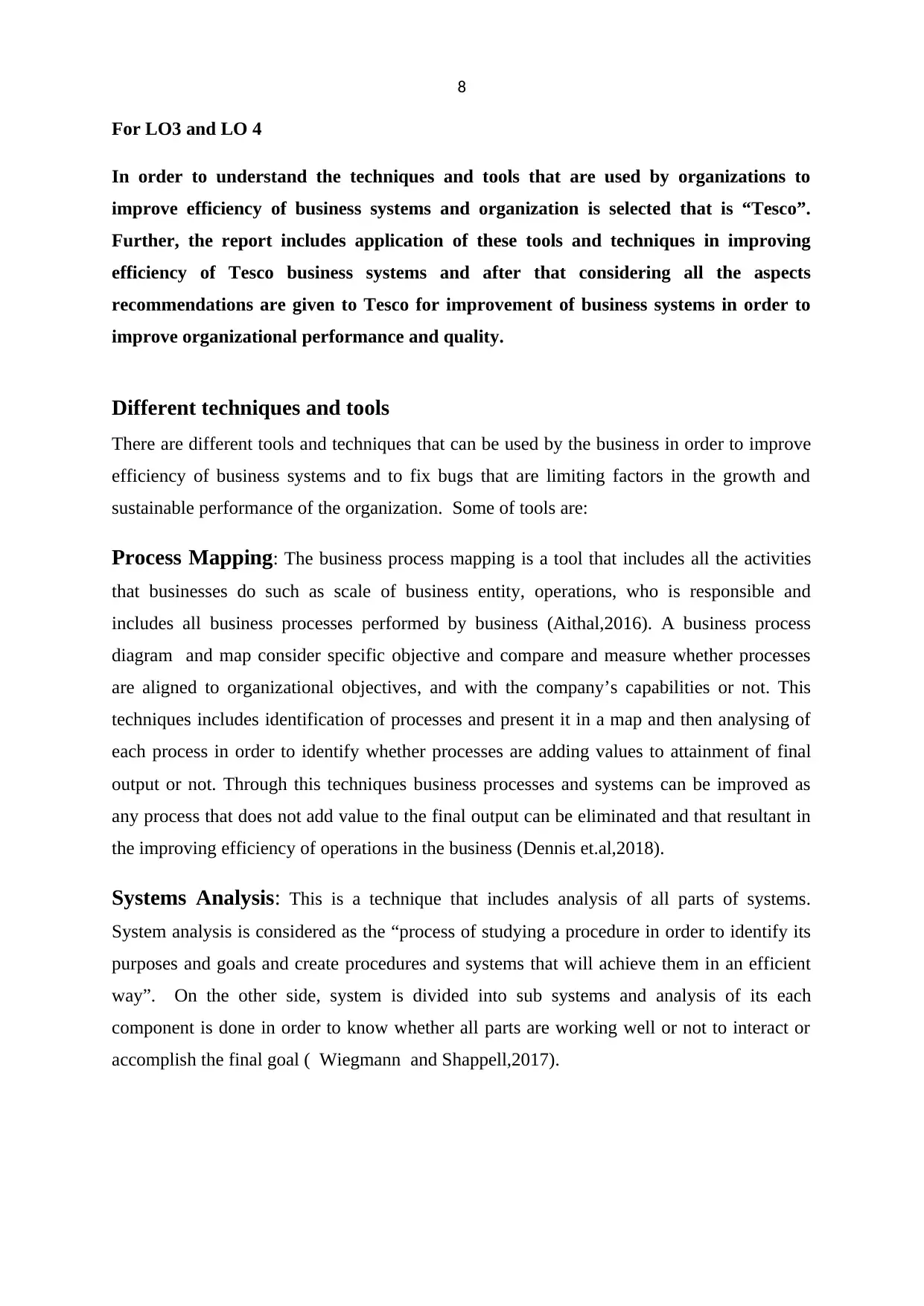
8
For LO3 and LO 4
In order to understand the techniques and tools that are used by organizations to
improve efficiency of business systems and organization is selected that is “Tesco”.
Further, the report includes application of these tools and techniques in improving
efficiency of Tesco business systems and after that considering all the aspects
recommendations are given to Tesco for improvement of business systems in order to
improve organizational performance and quality.
Different techniques and tools
There are different tools and techniques that can be used by the business in order to improve
efficiency of business systems and to fix bugs that are limiting factors in the growth and
sustainable performance of the organization. Some of tools are:
Process Mapping: The business process mapping is a tool that includes all the activities
that businesses do such as scale of business entity, operations, who is responsible and
includes all business processes performed by business (Aithal,2016). A business process
diagram and map consider specific objective and compare and measure whether processes
are aligned to organizational objectives, and with the company’s capabilities or not. This
techniques includes identification of processes and present it in a map and then analysing of
each process in order to identify whether processes are adding values to attainment of final
output or not. Through this techniques business processes and systems can be improved as
any process that does not add value to the final output can be eliminated and that resultant in
the improving efficiency of operations in the business (Dennis et.al,2018).
Systems Analysis: This is a technique that includes analysis of all parts of systems.
System analysis is considered as the “process of studying a procedure in order to identify its
purposes and goals and create procedures and systems that will achieve them in an efficient
way”. On the other side, system is divided into sub systems and analysis of its each
component is done in order to know whether all parts are working well or not to interact or
accomplish the final goal ( Wiegmann and Shappell,2017).
For LO3 and LO 4
In order to understand the techniques and tools that are used by organizations to
improve efficiency of business systems and organization is selected that is “Tesco”.
Further, the report includes application of these tools and techniques in improving
efficiency of Tesco business systems and after that considering all the aspects
recommendations are given to Tesco for improvement of business systems in order to
improve organizational performance and quality.
Different techniques and tools
There are different tools and techniques that can be used by the business in order to improve
efficiency of business systems and to fix bugs that are limiting factors in the growth and
sustainable performance of the organization. Some of tools are:
Process Mapping: The business process mapping is a tool that includes all the activities
that businesses do such as scale of business entity, operations, who is responsible and
includes all business processes performed by business (Aithal,2016). A business process
diagram and map consider specific objective and compare and measure whether processes
are aligned to organizational objectives, and with the company’s capabilities or not. This
techniques includes identification of processes and present it in a map and then analysing of
each process in order to identify whether processes are adding values to attainment of final
output or not. Through this techniques business processes and systems can be improved as
any process that does not add value to the final output can be eliminated and that resultant in
the improving efficiency of operations in the business (Dennis et.al,2018).
Systems Analysis: This is a technique that includes analysis of all parts of systems.
System analysis is considered as the “process of studying a procedure in order to identify its
purposes and goals and create procedures and systems that will achieve them in an efficient
way”. On the other side, system is divided into sub systems and analysis of its each
component is done in order to know whether all parts are working well or not to interact or
accomplish the final goal ( Wiegmann and Shappell,2017).
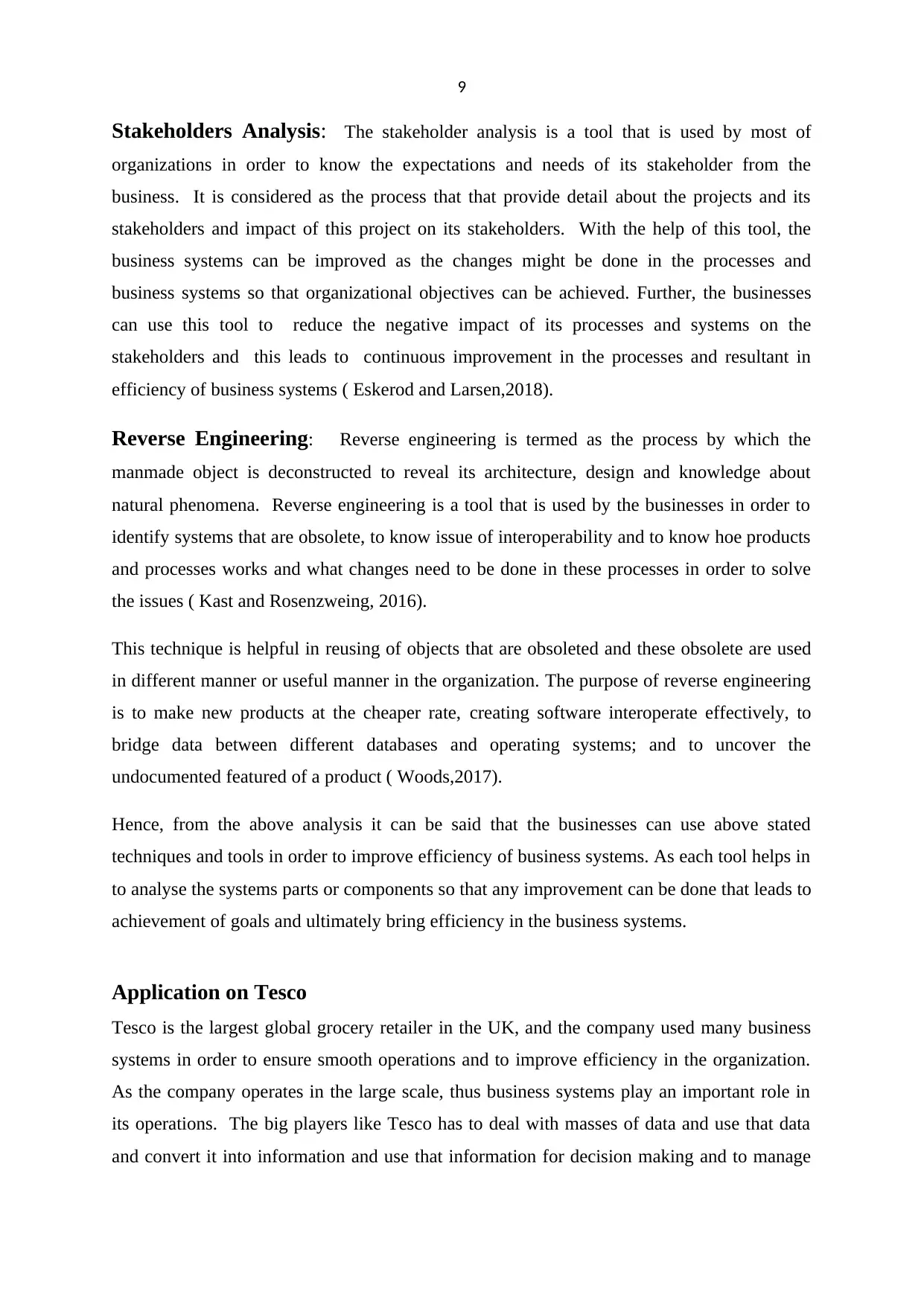
9
Stakeholders Analysis: The stakeholder analysis is a tool that is used by most of
organizations in order to know the expectations and needs of its stakeholder from the
business. It is considered as the process that that provide detail about the projects and its
stakeholders and impact of this project on its stakeholders. With the help of this tool, the
business systems can be improved as the changes might be done in the processes and
business systems so that organizational objectives can be achieved. Further, the businesses
can use this tool to reduce the negative impact of its processes and systems on the
stakeholders and this leads to continuous improvement in the processes and resultant in
efficiency of business systems ( Eskerod and Larsen,2018).
Reverse Engineering: Reverse engineering is termed as the process by which the
manmade object is deconstructed to reveal its architecture, design and knowledge about
natural phenomena. Reverse engineering is a tool that is used by the businesses in order to
identify systems that are obsolete, to know issue of interoperability and to know hoe products
and processes works and what changes need to be done in these processes in order to solve
the issues ( Kast and Rosenzweing, 2016).
This technique is helpful in reusing of objects that are obsoleted and these obsolete are used
in different manner or useful manner in the organization. The purpose of reverse engineering
is to make new products at the cheaper rate, creating software interoperate effectively, to
bridge data between different databases and operating systems; and to uncover the
undocumented featured of a product ( Woods,2017).
Hence, from the above analysis it can be said that the businesses can use above stated
techniques and tools in order to improve efficiency of business systems. As each tool helps in
to analyse the systems parts or components so that any improvement can be done that leads to
achievement of goals and ultimately bring efficiency in the business systems.
Application on Tesco
Tesco is the largest global grocery retailer in the UK, and the company used many business
systems in order to ensure smooth operations and to improve efficiency in the organization.
As the company operates in the large scale, thus business systems play an important role in
its operations. The big players like Tesco has to deal with masses of data and use that data
and convert it into information and use that information for decision making and to manage
Stakeholders Analysis: The stakeholder analysis is a tool that is used by most of
organizations in order to know the expectations and needs of its stakeholder from the
business. It is considered as the process that that provide detail about the projects and its
stakeholders and impact of this project on its stakeholders. With the help of this tool, the
business systems can be improved as the changes might be done in the processes and
business systems so that organizational objectives can be achieved. Further, the businesses
can use this tool to reduce the negative impact of its processes and systems on the
stakeholders and this leads to continuous improvement in the processes and resultant in
efficiency of business systems ( Eskerod and Larsen,2018).
Reverse Engineering: Reverse engineering is termed as the process by which the
manmade object is deconstructed to reveal its architecture, design and knowledge about
natural phenomena. Reverse engineering is a tool that is used by the businesses in order to
identify systems that are obsolete, to know issue of interoperability and to know hoe products
and processes works and what changes need to be done in these processes in order to solve
the issues ( Kast and Rosenzweing, 2016).
This technique is helpful in reusing of objects that are obsoleted and these obsolete are used
in different manner or useful manner in the organization. The purpose of reverse engineering
is to make new products at the cheaper rate, creating software interoperate effectively, to
bridge data between different databases and operating systems; and to uncover the
undocumented featured of a product ( Woods,2017).
Hence, from the above analysis it can be said that the businesses can use above stated
techniques and tools in order to improve efficiency of business systems. As each tool helps in
to analyse the systems parts or components so that any improvement can be done that leads to
achievement of goals and ultimately bring efficiency in the business systems.
Application on Tesco
Tesco is the largest global grocery retailer in the UK, and the company used many business
systems in order to ensure smooth operations and to improve efficiency in the organization.
As the company operates in the large scale, thus business systems play an important role in
its operations. The big players like Tesco has to deal with masses of data and use that data
and convert it into information and use that information for decision making and to manage
Secure Best Marks with AI Grader
Need help grading? Try our AI Grader for instant feedback on your assignments.
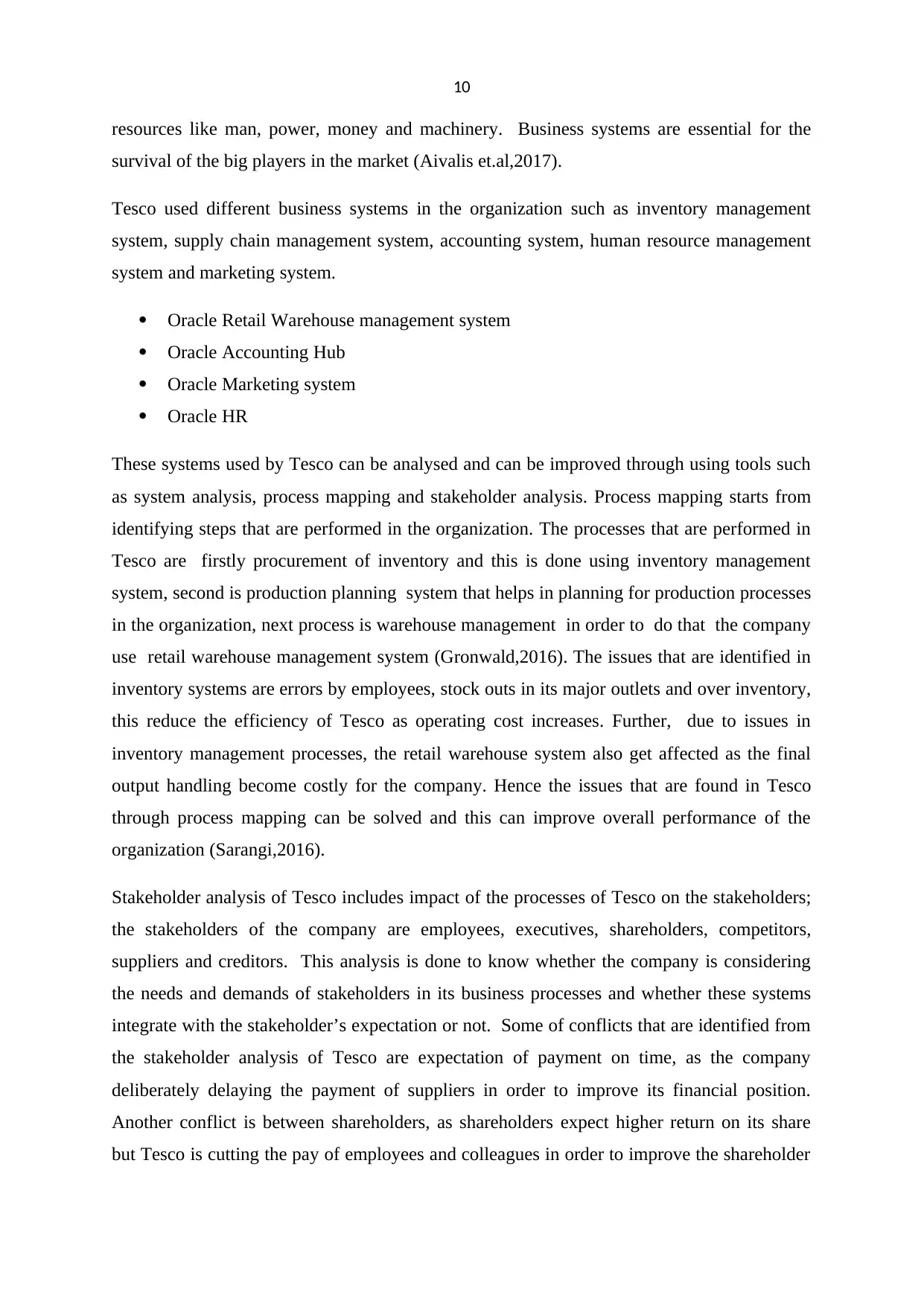
10
resources like man, power, money and machinery. Business systems are essential for the
survival of the big players in the market (Aivalis et.al,2017).
Tesco used different business systems in the organization such as inventory management
system, supply chain management system, accounting system, human resource management
system and marketing system.
Oracle Retail Warehouse management system
Oracle Accounting Hub
Oracle Marketing system
Oracle HR
These systems used by Tesco can be analysed and can be improved through using tools such
as system analysis, process mapping and stakeholder analysis. Process mapping starts from
identifying steps that are performed in the organization. The processes that are performed in
Tesco are firstly procurement of inventory and this is done using inventory management
system, second is production planning system that helps in planning for production processes
in the organization, next process is warehouse management in order to do that the company
use retail warehouse management system (Gronwald,2016). The issues that are identified in
inventory systems are errors by employees, stock outs in its major outlets and over inventory,
this reduce the efficiency of Tesco as operating cost increases. Further, due to issues in
inventory management processes, the retail warehouse system also get affected as the final
output handling become costly for the company. Hence the issues that are found in Tesco
through process mapping can be solved and this can improve overall performance of the
organization (Sarangi,2016).
Stakeholder analysis of Tesco includes impact of the processes of Tesco on the stakeholders;
the stakeholders of the company are employees, executives, shareholders, competitors,
suppliers and creditors. This analysis is done to know whether the company is considering
the needs and demands of stakeholders in its business processes and whether these systems
integrate with the stakeholder’s expectation or not. Some of conflicts that are identified from
the stakeholder analysis of Tesco are expectation of payment on time, as the company
deliberately delaying the payment of suppliers in order to improve its financial position.
Another conflict is between shareholders, as shareholders expect higher return on its share
but Tesco is cutting the pay of employees and colleagues in order to improve the shareholder
resources like man, power, money and machinery. Business systems are essential for the
survival of the big players in the market (Aivalis et.al,2017).
Tesco used different business systems in the organization such as inventory management
system, supply chain management system, accounting system, human resource management
system and marketing system.
Oracle Retail Warehouse management system
Oracle Accounting Hub
Oracle Marketing system
Oracle HR
These systems used by Tesco can be analysed and can be improved through using tools such
as system analysis, process mapping and stakeholder analysis. Process mapping starts from
identifying steps that are performed in the organization. The processes that are performed in
Tesco are firstly procurement of inventory and this is done using inventory management
system, second is production planning system that helps in planning for production processes
in the organization, next process is warehouse management in order to do that the company
use retail warehouse management system (Gronwald,2016). The issues that are identified in
inventory systems are errors by employees, stock outs in its major outlets and over inventory,
this reduce the efficiency of Tesco as operating cost increases. Further, due to issues in
inventory management processes, the retail warehouse system also get affected as the final
output handling become costly for the company. Hence the issues that are found in Tesco
through process mapping can be solved and this can improve overall performance of the
organization (Sarangi,2016).
Stakeholder analysis of Tesco includes impact of the processes of Tesco on the stakeholders;
the stakeholders of the company are employees, executives, shareholders, competitors,
suppliers and creditors. This analysis is done to know whether the company is considering
the needs and demands of stakeholders in its business processes and whether these systems
integrate with the stakeholder’s expectation or not. Some of conflicts that are identified from
the stakeholder analysis of Tesco are expectation of payment on time, as the company
deliberately delaying the payment of suppliers in order to improve its financial position.
Another conflict is between shareholders, as shareholders expect higher return on its share
but Tesco is cutting the pay of employees and colleagues in order to improve the shareholder
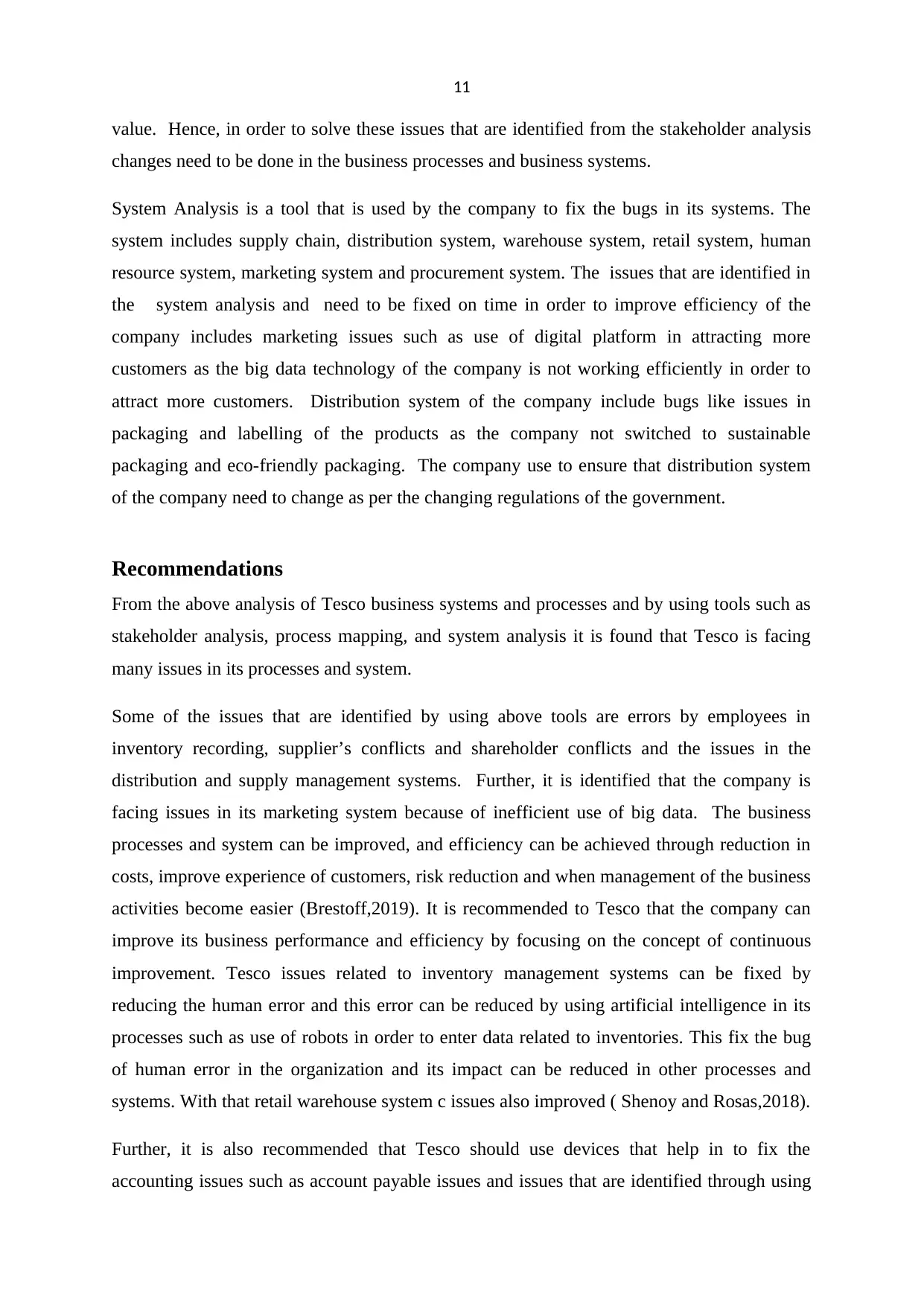
11
value. Hence, in order to solve these issues that are identified from the stakeholder analysis
changes need to be done in the business processes and business systems.
System Analysis is a tool that is used by the company to fix the bugs in its systems. The
system includes supply chain, distribution system, warehouse system, retail system, human
resource system, marketing system and procurement system. The issues that are identified in
the system analysis and need to be fixed on time in order to improve efficiency of the
company includes marketing issues such as use of digital platform in attracting more
customers as the big data technology of the company is not working efficiently in order to
attract more customers. Distribution system of the company include bugs like issues in
packaging and labelling of the products as the company not switched to sustainable
packaging and eco-friendly packaging. The company use to ensure that distribution system
of the company need to change as per the changing regulations of the government.
Recommendations
From the above analysis of Tesco business systems and processes and by using tools such as
stakeholder analysis, process mapping, and system analysis it is found that Tesco is facing
many issues in its processes and system.
Some of the issues that are identified by using above tools are errors by employees in
inventory recording, supplier’s conflicts and shareholder conflicts and the issues in the
distribution and supply management systems. Further, it is identified that the company is
facing issues in its marketing system because of inefficient use of big data. The business
processes and system can be improved, and efficiency can be achieved through reduction in
costs, improve experience of customers, risk reduction and when management of the business
activities become easier (Brestoff,2019). It is recommended to Tesco that the company can
improve its business performance and efficiency by focusing on the concept of continuous
improvement. Tesco issues related to inventory management systems can be fixed by
reducing the human error and this error can be reduced by using artificial intelligence in its
processes such as use of robots in order to enter data related to inventories. This fix the bug
of human error in the organization and its impact can be reduced in other processes and
systems. With that retail warehouse system c issues also improved ( Shenoy and Rosas,2018).
Further, it is also recommended that Tesco should use devices that help in to fix the
accounting issues such as account payable issues and issues that are identified through using
value. Hence, in order to solve these issues that are identified from the stakeholder analysis
changes need to be done in the business processes and business systems.
System Analysis is a tool that is used by the company to fix the bugs in its systems. The
system includes supply chain, distribution system, warehouse system, retail system, human
resource system, marketing system and procurement system. The issues that are identified in
the system analysis and need to be fixed on time in order to improve efficiency of the
company includes marketing issues such as use of digital platform in attracting more
customers as the big data technology of the company is not working efficiently in order to
attract more customers. Distribution system of the company include bugs like issues in
packaging and labelling of the products as the company not switched to sustainable
packaging and eco-friendly packaging. The company use to ensure that distribution system
of the company need to change as per the changing regulations of the government.
Recommendations
From the above analysis of Tesco business systems and processes and by using tools such as
stakeholder analysis, process mapping, and system analysis it is found that Tesco is facing
many issues in its processes and system.
Some of the issues that are identified by using above tools are errors by employees in
inventory recording, supplier’s conflicts and shareholder conflicts and the issues in the
distribution and supply management systems. Further, it is identified that the company is
facing issues in its marketing system because of inefficient use of big data. The business
processes and system can be improved, and efficiency can be achieved through reduction in
costs, improve experience of customers, risk reduction and when management of the business
activities become easier (Brestoff,2019). It is recommended to Tesco that the company can
improve its business performance and efficiency by focusing on the concept of continuous
improvement. Tesco issues related to inventory management systems can be fixed by
reducing the human error and this error can be reduced by using artificial intelligence in its
processes such as use of robots in order to enter data related to inventories. This fix the bug
of human error in the organization and its impact can be reduced in other processes and
systems. With that retail warehouse system c issues also improved ( Shenoy and Rosas,2018).
Further, it is also recommended that Tesco should use devices that help in to fix the
accounting issues such as account payable issues and issues that are identified through using
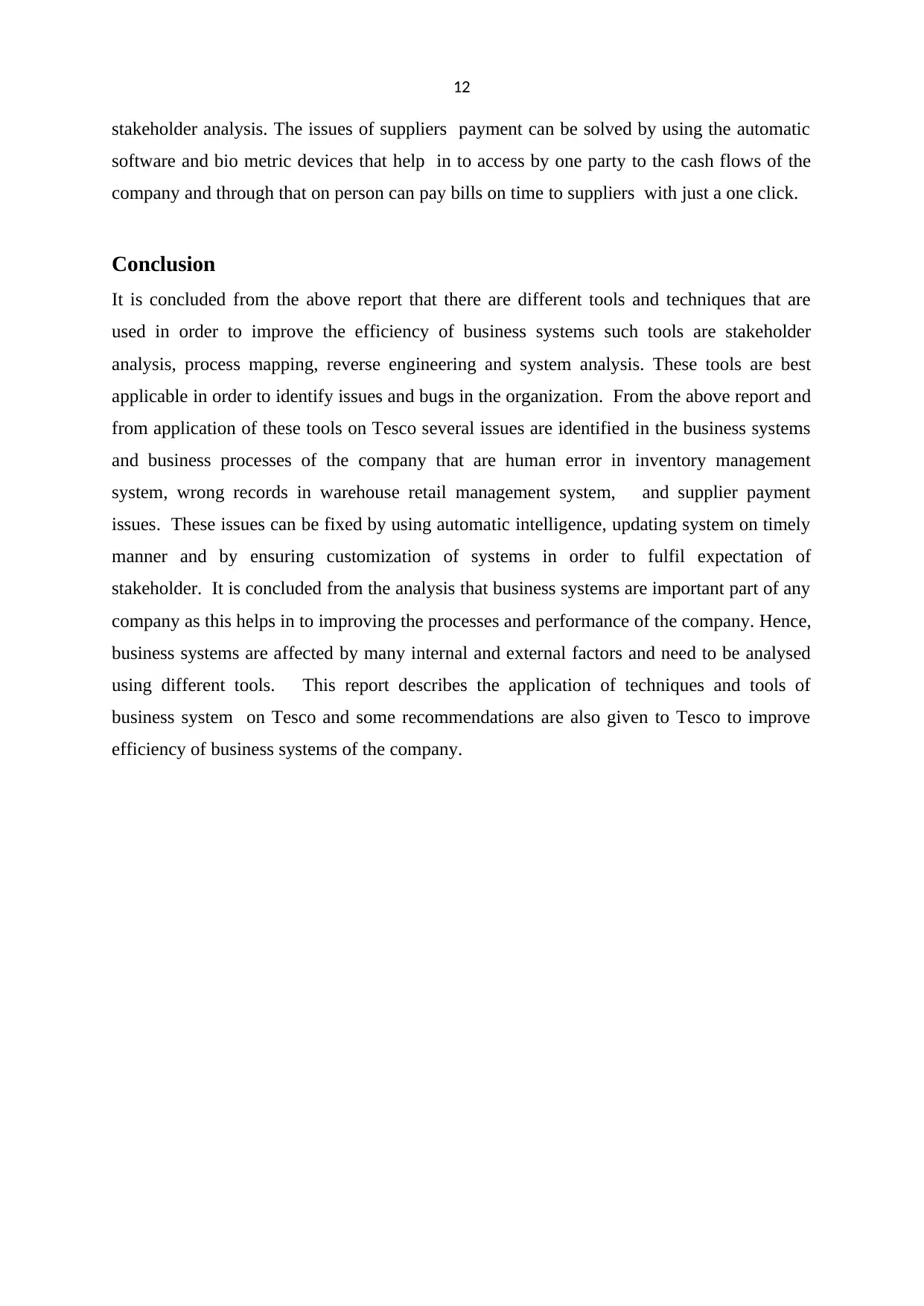
12
stakeholder analysis. The issues of suppliers payment can be solved by using the automatic
software and bio metric devices that help in to access by one party to the cash flows of the
company and through that on person can pay bills on time to suppliers with just a one click.
Conclusion
It is concluded from the above report that there are different tools and techniques that are
used in order to improve the efficiency of business systems such tools are stakeholder
analysis, process mapping, reverse engineering and system analysis. These tools are best
applicable in order to identify issues and bugs in the organization. From the above report and
from application of these tools on Tesco several issues are identified in the business systems
and business processes of the company that are human error in inventory management
system, wrong records in warehouse retail management system, and supplier payment
issues. These issues can be fixed by using automatic intelligence, updating system on timely
manner and by ensuring customization of systems in order to fulfil expectation of
stakeholder. It is concluded from the analysis that business systems are important part of any
company as this helps in to improving the processes and performance of the company. Hence,
business systems are affected by many internal and external factors and need to be analysed
using different tools. This report describes the application of techniques and tools of
business system on Tesco and some recommendations are also given to Tesco to improve
efficiency of business systems of the company.
stakeholder analysis. The issues of suppliers payment can be solved by using the automatic
software and bio metric devices that help in to access by one party to the cash flows of the
company and through that on person can pay bills on time to suppliers with just a one click.
Conclusion
It is concluded from the above report that there are different tools and techniques that are
used in order to improve the efficiency of business systems such tools are stakeholder
analysis, process mapping, reverse engineering and system analysis. These tools are best
applicable in order to identify issues and bugs in the organization. From the above report and
from application of these tools on Tesco several issues are identified in the business systems
and business processes of the company that are human error in inventory management
system, wrong records in warehouse retail management system, and supplier payment
issues. These issues can be fixed by using automatic intelligence, updating system on timely
manner and by ensuring customization of systems in order to fulfil expectation of
stakeholder. It is concluded from the analysis that business systems are important part of any
company as this helps in to improving the processes and performance of the company. Hence,
business systems are affected by many internal and external factors and need to be analysed
using different tools. This report describes the application of techniques and tools of
business system on Tesco and some recommendations are also given to Tesco to improve
efficiency of business systems of the company.
Paraphrase This Document
Need a fresh take? Get an instant paraphrase of this document with our AI Paraphraser
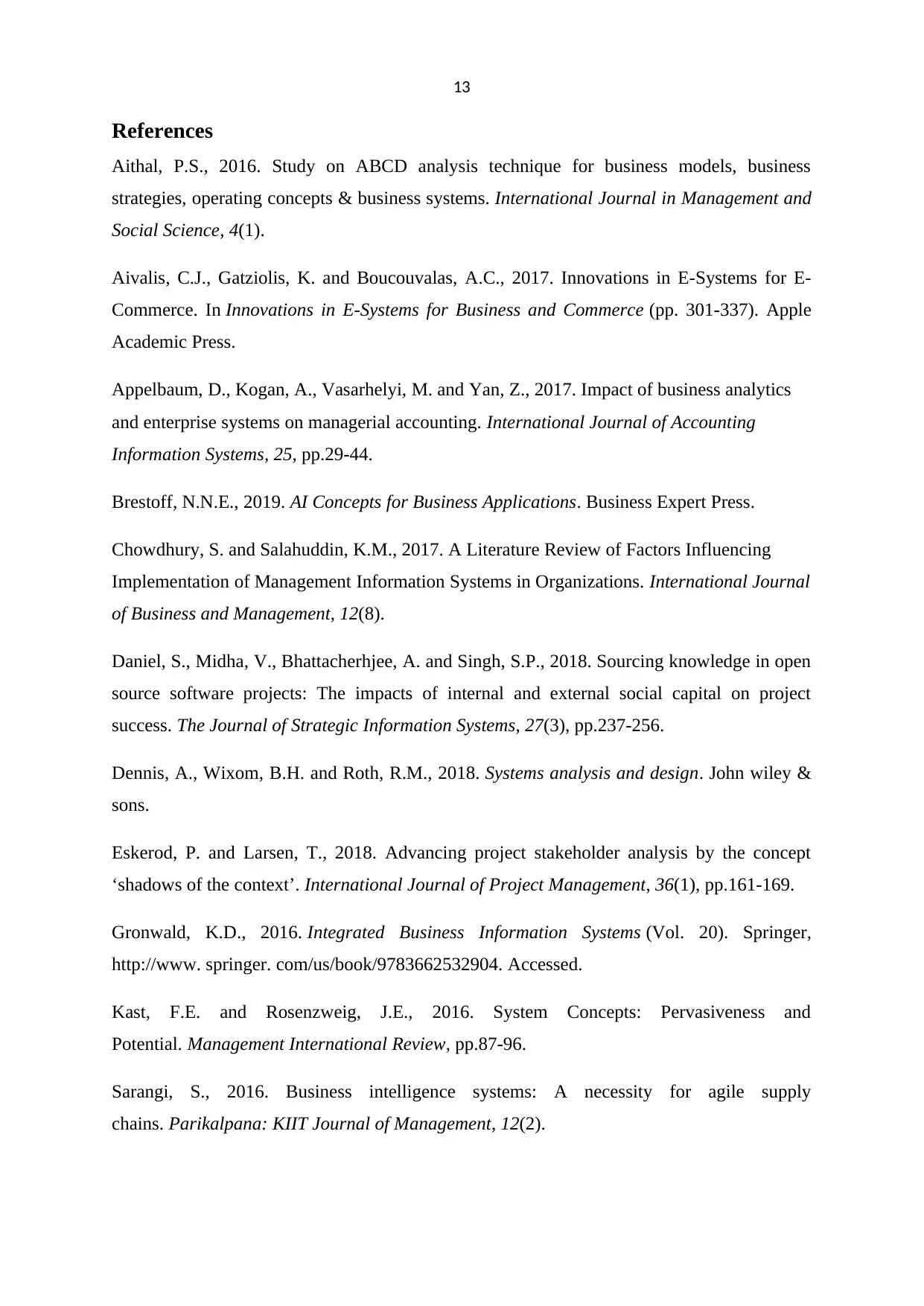
13
References
Aithal, P.S., 2016. Study on ABCD analysis technique for business models, business
strategies, operating concepts & business systems. International Journal in Management and
Social Science, 4(1).
Aivalis, C.J., Gatziolis, K. and Boucouvalas, A.C., 2017. Innovations in E-Systems for E-
Commerce. In Innovations in E-Systems for Business and Commerce (pp. 301-337). Apple
Academic Press.
Appelbaum, D., Kogan, A., Vasarhelyi, M. and Yan, Z., 2017. Impact of business analytics
and enterprise systems on managerial accounting. International Journal of Accounting
Information Systems, 25, pp.29-44.
Brestoff, N.N.E., 2019. AI Concepts for Business Applications. Business Expert Press.
Chowdhury, S. and Salahuddin, K.M., 2017. A Literature Review of Factors Influencing
Implementation of Management Information Systems in Organizations. International Journal
of Business and Management, 12(8).
Daniel, S., Midha, V., Bhattacherhjee, A. and Singh, S.P., 2018. Sourcing knowledge in open
source software projects: The impacts of internal and external social capital on project
success. The Journal of Strategic Information Systems, 27(3), pp.237-256.
Dennis, A., Wixom, B.H. and Roth, R.M., 2018. Systems analysis and design. John wiley &
sons.
Eskerod, P. and Larsen, T., 2018. Advancing project stakeholder analysis by the concept
‘shadows of the context’. International Journal of Project Management, 36(1), pp.161-169.
Gronwald, K.D., 2016. Integrated Business Information Systems (Vol. 20). Springer,
http://www. springer. com/us/book/9783662532904. Accessed.
Kast, F.E. and Rosenzweig, J.E., 2016. System Concepts: Pervasiveness and
Potential. Management International Review, pp.87-96.
Sarangi, S., 2016. Business intelligence systems: A necessity for agile supply
chains. Parikalpana: KIIT Journal of Management, 12(2).
References
Aithal, P.S., 2016. Study on ABCD analysis technique for business models, business
strategies, operating concepts & business systems. International Journal in Management and
Social Science, 4(1).
Aivalis, C.J., Gatziolis, K. and Boucouvalas, A.C., 2017. Innovations in E-Systems for E-
Commerce. In Innovations in E-Systems for Business and Commerce (pp. 301-337). Apple
Academic Press.
Appelbaum, D., Kogan, A., Vasarhelyi, M. and Yan, Z., 2017. Impact of business analytics
and enterprise systems on managerial accounting. International Journal of Accounting
Information Systems, 25, pp.29-44.
Brestoff, N.N.E., 2019. AI Concepts for Business Applications. Business Expert Press.
Chowdhury, S. and Salahuddin, K.M., 2017. A Literature Review of Factors Influencing
Implementation of Management Information Systems in Organizations. International Journal
of Business and Management, 12(8).
Daniel, S., Midha, V., Bhattacherhjee, A. and Singh, S.P., 2018. Sourcing knowledge in open
source software projects: The impacts of internal and external social capital on project
success. The Journal of Strategic Information Systems, 27(3), pp.237-256.
Dennis, A., Wixom, B.H. and Roth, R.M., 2018. Systems analysis and design. John wiley &
sons.
Eskerod, P. and Larsen, T., 2018. Advancing project stakeholder analysis by the concept
‘shadows of the context’. International Journal of Project Management, 36(1), pp.161-169.
Gronwald, K.D., 2016. Integrated Business Information Systems (Vol. 20). Springer,
http://www. springer. com/us/book/9783662532904. Accessed.
Kast, F.E. and Rosenzweig, J.E., 2016. System Concepts: Pervasiveness and
Potential. Management International Review, pp.87-96.
Sarangi, S., 2016. Business intelligence systems: A necessity for agile supply
chains. Parikalpana: KIIT Journal of Management, 12(2).
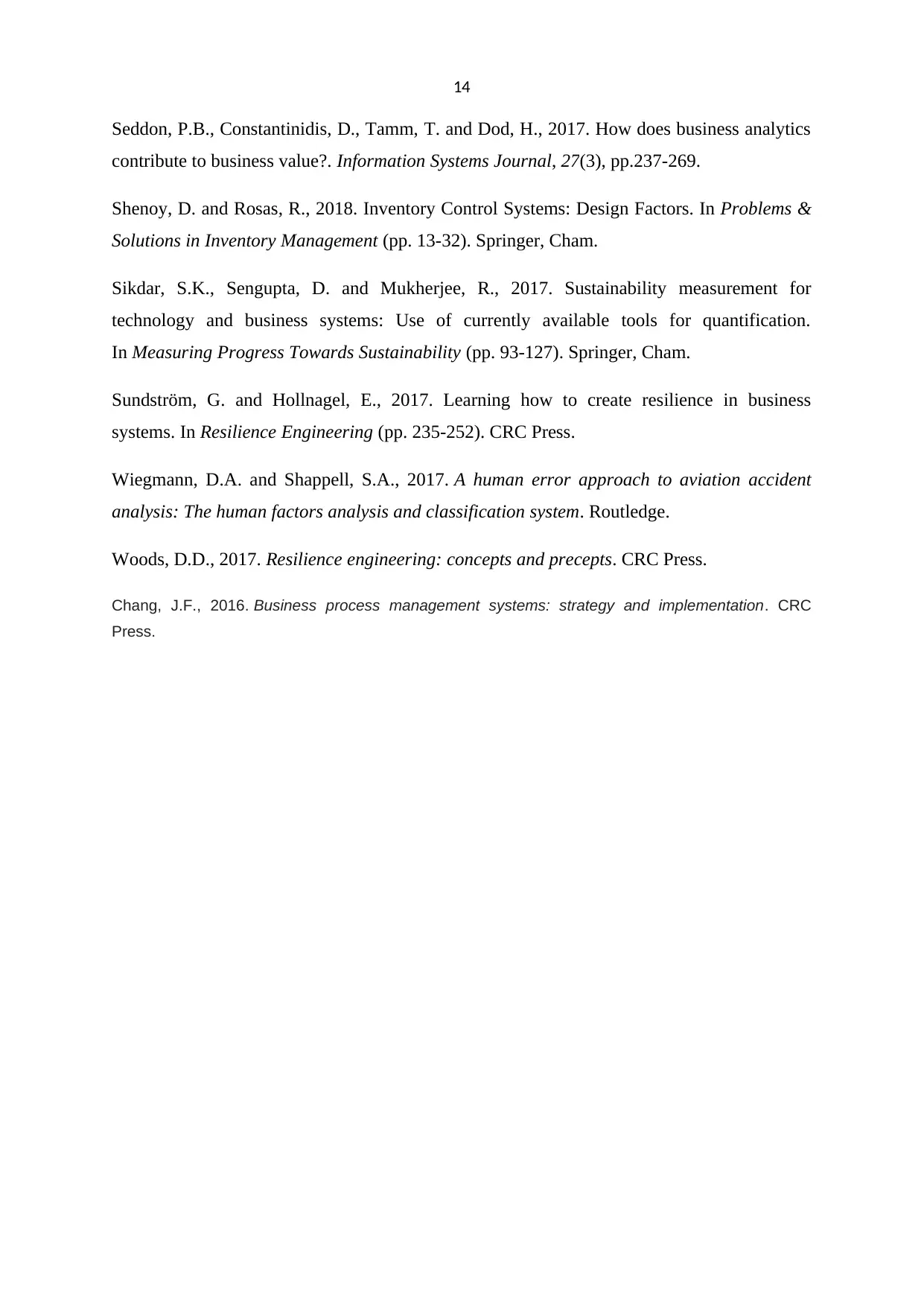
14
Seddon, P.B., Constantinidis, D., Tamm, T. and Dod, H., 2017. How does business analytics
contribute to business value?. Information Systems Journal, 27(3), pp.237-269.
Shenoy, D. and Rosas, R., 2018. Inventory Control Systems: Design Factors. In Problems &
Solutions in Inventory Management (pp. 13-32). Springer, Cham.
Sikdar, S.K., Sengupta, D. and Mukherjee, R., 2017. Sustainability measurement for
technology and business systems: Use of currently available tools for quantification.
In Measuring Progress Towards Sustainability (pp. 93-127). Springer, Cham.
Sundström, G. and Hollnagel, E., 2017. Learning how to create resilience in business
systems. In Resilience Engineering (pp. 235-252). CRC Press.
Wiegmann, D.A. and Shappell, S.A., 2017. A human error approach to aviation accident
analysis: The human factors analysis and classification system. Routledge.
Woods, D.D., 2017. Resilience engineering: concepts and precepts. CRC Press.
Chang, J.F., 2016. Business process management systems: strategy and implementation. CRC
Press.
Seddon, P.B., Constantinidis, D., Tamm, T. and Dod, H., 2017. How does business analytics
contribute to business value?. Information Systems Journal, 27(3), pp.237-269.
Shenoy, D. and Rosas, R., 2018. Inventory Control Systems: Design Factors. In Problems &
Solutions in Inventory Management (pp. 13-32). Springer, Cham.
Sikdar, S.K., Sengupta, D. and Mukherjee, R., 2017. Sustainability measurement for
technology and business systems: Use of currently available tools for quantification.
In Measuring Progress Towards Sustainability (pp. 93-127). Springer, Cham.
Sundström, G. and Hollnagel, E., 2017. Learning how to create resilience in business
systems. In Resilience Engineering (pp. 235-252). CRC Press.
Wiegmann, D.A. and Shappell, S.A., 2017. A human error approach to aviation accident
analysis: The human factors analysis and classification system. Routledge.
Woods, D.D., 2017. Resilience engineering: concepts and precepts. CRC Press.
Chang, J.F., 2016. Business process management systems: strategy and implementation. CRC
Press.
1 out of 15
Related Documents
Your All-in-One AI-Powered Toolkit for Academic Success.
+13062052269
info@desklib.com
Available 24*7 on WhatsApp / Email
![[object Object]](/_next/static/media/star-bottom.7253800d.svg)
Unlock your academic potential
© 2024 | Zucol Services PVT LTD | All rights reserved.




